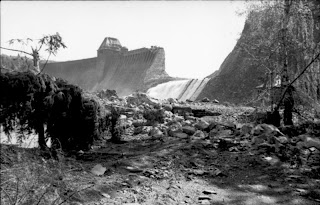 |
| A surviving Bouncing Bomb |
The concept behind the bouncing bomb is a classic case of applied physics. The bomb is spun in the opposite direction in which the carrying plane is flying, so when the plane drops the bomb on the water the counter spin keeps the bomb above the water while decelerating at the same time. Ideally, when the bomb decelerates enough to the point it sinks, it is situated right next to the dam wall, where it explodes. since water acts as a better energy transference medium than air, the shock wave created deals massive damage to the walls of the dam, which ideally burst as a result.
If the execution of this sounds simple, it is in fact much more complicated. For starters, the bomb weighs five tons, and at this time only the largest and heaviest bombers could handle a bomb load like that, not including the weight of the special bomb mount. Furthermore, in order to get the bomb into position and past the torpedo nets in place in front of the dam wall, the bomb has to be dropped in a very narrow target area, at low altitude, all the while avoiding heavy antiaircraft fire on the approach. Needless to say, this mission demanded the most out of these brave men.
 |
| Aftermath of the Eder Dam |
 |
| Aftermath of the Mohne Dam |
In the end, the attacks on the dams of the Ruhr valley caused massive damage both in the loss of hydroelectric power as well as the massive flood damage caused in the valley villages. No mission before or since has ever come close to needing this kind of bravery and guts. In testament to the flyer's courage and sacrifice, a memorial to both the dead and surviving pilots is in Lincolnshire, England. Until next time, take care, and thanks for reading.
No comments:
Post a Comment